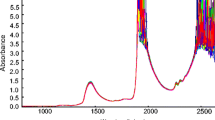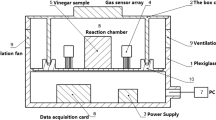Abstract
The aims of this study were to explore the most important volatile aroma compounds of Chinese vinegars and to apply the artificial neural networks (ANN) to classify Chinese vinegars. A total of 101 volatile aroma components, which include 21 esters, 16 aldehydes, 15 acids, 19 alcohols, 10 ketones, 9 phenols, 5 pyrazines, 3 furans, and 3 miscellaneous compounds, were identified by gas chromatography mass spectrometry. On the basis of sensitivity analysis, 6 and 11 volatile aroma compounds were selected and proved to be useful for classifying Chinese vinegars by fermentation method and geographic region, respectively. The variables with the greatest contribution in the classification of Chinese vinegars by geographic region were 2-methoxy-4-methylphenol and acetic acid, whereas 3-methylbutanoic acid and furfural played the most important roles in fermentation method classification. ANN could classify Chinese vinegars based on fermentation method and geographic region with a prediction success rate of 100%. This level was higher than the accuracy of cluster analysis, linear discriminant analysis, and K-nearest neighbor. Results showed that ANN was a useful model for classifying Chinese vinegars.


Similar content being viewed by others
References
Aili W, Huanlu S, Changzhong R, Zaigui L (2012) Key aroma compounds in Shanxi aged tartary buckwheat vinegar and changes during its thermal processing. Flavour Frag J 27(1):47–53
Caligiani A, Silva G, Palla G (2007) Determination of 2,3-butanediol and 2-hydroxybutanone stereoisomers in batteries of traditional Balsamic vinegar. J Agric Food Chem 55(19):7810–7815
Chen T, Gui Q, Shi JJ, Zhang XY, Chen FS (2013) Analysis of variation of main components during aging process of Shanxi aged vinegar. Acetic Acid Bacteria 2:31–37
Chen Q, Sun C, Ouyang Q, Liu A, Li H, Zhao J (2014) Classification of vinegar with different marked ages using olfactory sensors and gustatory sensors. Anal Methods-Uk 6(24):9783–9790
Cirlini M, Caligiani A, Palla L, Palla G (2011) HS-SPME/GC–MS and chemometrics for the classification of Balsamic vinegars of Modena of different maturation and ageing. Food Chem 124(4):1678–1683
Da Silva CET, Filardi VL, Pepe IM, Chaves MA, Santos CMS (2015) Classification of food vegetable oils by fluorimetry and artificial neural networks. Food Control 47:86–91
Duraklı-Velioğlu S, Boyacı İH, Şimşek O, Gümüş T (2013) Optimizing a submerged Monascus cultivation for production of red pigment with bug damaged wheat using artificial neural networks. Food Sci Biotechnol 22(6):1639–1648
Fors S (1983) Sensory properties of volatile Maillard reaction products and related compounds: a literature review. In: Waller GR, Feather MS (eds) The Maillard reaction in foods and nutrition. American Chemical Society, Washington DC, pp 185–286
Frauendorfer F, Schieberle P (2008) Changes in key aroma compounds of Cri ollo co coa beans during roasting. J Agric Food Chem 56(21):10244–10251
Gilbertson G, Koenig RT (1981) Essential oils and related products. Anal Chem 53(5):61R–77R
Huang Z (1998) The status and trends of Chinese vinegar. China Condiment 1:3–4
Iraqi R, Vermeulen C, Benzekri A, Bouseta A, Collin S (2005) Screening for key odorants in Moroccan green olives by gas chromatography-olfactometry/aroma extract dilution analysis. J Agric Food Chem 53(4):1179–1184
Jordán MJ, Shaw PE, Goodner KL (2001) Volatile components in aqueous essence and fresh fruit of Cucumis melo cv. Athena (Muskmelon) by GC-MS and GC-O. J Agric Food Chem 49(12):5929–5933
Kotseridis Y, Baumes R (2000) Identification of impact odorants in Bordeaux red grape juice, in the commercial yeast used for its fermentation, and in the produced wine. J Agric Food Chem 48(2):400–406
Kruzlicova D, Mocak J, Balla B, Petka J, Farkova M, Havel J (2009) Classification of Slovak white wines using artificial neural networks and discriminant techniques. Food Chem 112(4):1046–1052
Li P, Li S, Cheng L, Luo L (2014) Analyzing the relation between the microbial diver sity of DaQu and the turbidity spoilage of traditional Chinese vinegar. Appl Microbiol Biot 98(13):6073–6084
Liu J (1982) Fujian Yunchun old vinegar. China Brewing 1:30–31
Liu K (2010) Discuss Chinese vinegar function and trend of development. China Condiment 6:32–39
Liu D, Zhu Y, Beeftink R, Ooijkaas L, Rinzema A, Chen J, Tramper J (2004) Chinese vinegar and its solid-state fermentation process. Food Rev Int 20(4):407–424
Mohebbi A, Taheri M, Soltani A (2008) A neural network for predicting saturated liquid density using genetic algorithm for pure and mixed refrigerants. Int J Refrig 31(8):1317–1327
Mohebbi M, Fathi M, Shahidi F (2011) Genetic algorithm-artificial neural network modeling of moisture and oil content of pretreated fried mushroom. Food Bioprocess Tech 4(4):603–609
Morales ML, González GA, Casas JA, Troncoso AM (2001) Multivariate analysis of commercial and laboratory produced Sherry wine vinegars: influence of acetification and aging. Eur Food Res Technol 212(6):676–682
Qi W, Wang C, Cao X, Zhao G, Wang C, Hou L (2013) Flavour analysis of Chinese cereal vinegar. IERI Procedia 5:332–338
Saemi M, Ahmadi M, Varjani AY (2007) Design of neural networks using genetic algorithm for the permeability estimation of the reservoir. J Pet Sci Eng 59(1):97–105
Salehi F, Razavi SM (2012) Dynamic modeling of flux and total hydraulic resistance in nanofiltration treatment of regeneration waste brine using artificial neural networks. Desalin Water Treat 41(1–3):95–104
Shankar TJ, Sokhansanj S, Bandyopadhyay S, Bawa AS (2010) A case study on optimization of bio mass flow during single-screw extrusion cooking using genetic algorithm (GA) and response surface method (RSM). Food Bioprocess Tech 3(4):498–510
Shi G (1999) Talk about Chinese vinegar. China Brewing 6:39–40
Xiao Z, Dai S, Niu Y, Yu H, Zhu J, Tian H, Gu Y (2011) Discrimination of Chinese vinegars based on headspace solid-phase microextraction-gas chromatography mass spectrometry of volatile compounds and multivariate analysis. J Food Sci 76(8):C1125–C1135
Xu W, Xu Q, Chen J, Lu Z, Xia R, Li G, Ma Y (2011) Ligustrazine formation in Zhen jiang aromatic vinegar: changes during fermentation and storing process. J Sci Food Agr 91(9):1612–1617
Xu L, Li Y, Xu N, Hu Y, Wang C, He J, Li D (2014) Soy sauce classification by geo graphic region and fermentation based on artificial neural network and genetic algorithm. J Agr Food Chem 62(51):12294–12298
Yan WF (2004) Improvement of the traditional yongchun Monascus vinegar’s compounding technology. Jiangsu Condiment and Subsidiary Food 21:16–17
Yu YJ, Lu ZM, Yu NH, Xu W, Li GQ, Shi JS, Xu ZH (2012) HS-SPME/GC-MS and chemometrics for volatile composition of Chinese traditional aromatic vinegar in the Zhenjiang region. J I Brewing 118(1):133–141
Zhang Q, Zhang S, Xie C, Zeng D, Fan C, Li D, Bai Z (2006) Characterization of Chinese vinegars by electronic nose. Sensor Actuat B-Chem 119(2):538–546
Zheng N, Chen F, Wang Z, Lin J (2013) Modeling and optimization of artificial neural network and response surface methodology in ultra-high-pressure extraction of Artemisia argyi Levl. et Vant and its antifungal activity. Food Anal Method 6(2):421–431
Zheng Y, Ruan G, Li B, Xiong C, Chen S, Luo M, Du F (2014) Multicomposition analysis and pattern recognition of Chinese geographical indication product: vinegar. Eur Food Res Techn 238(2):337–344
Zhu H, Zhu J, Wang L, Li Z (2016) Development of a SPME-GC-MS method for the determination of volatile compounds in Shanxi aged vinegar and its analytical characterization by aroma wheel. J Food Sci Tech 53(1):171–183
Acknowledgements
This work was supported by Natural Science Foundation of Hubei Province (2015CFB678), Young Talent Project of Hubei Provincial Education Department (Q20151412), and Startup Foundation for Doctors of Hubei University of Technology (Grant No. BSQD10036).
Author information
Authors and Affiliations
Corresponding authors
Ethics declarations
Conflict of Interest
Yang Chen declares that he has no conflict of interest. Ye Bai declares that he has no conflict of interest. Ning Xu declares that he has no conflict of interest. Mengzhou Zhou declares that he has no conflict of interest. Chao Wang declares that he has no conflict of interest. Dongsheng Li declares that he has no conflict of interest. Yong Hu declares that he has no conflict of interest.
Ethical Approval
This article does not contain any studies with animals performed by any of the authors.
Informed Consent
Informed consent was obtained from all individual participants included in the study.
Additional information
Yang Chen and Ye Bai contributed equally to this work.
Electronic supplementary material
Figure S1
Schematic of optimization procedure of neural network using genetic algorithm. (GIF 44 kb)
Online resource image
(TIFF 1362 kb)
Table S1
(DOCX 33 kb)
Table S2
(DOC 182 kb)
Table S3
(DOC 200 kb)
Rights and permissions
About this article
Cite this article
Chen, Y., Bai, Y., Xu, N. et al. Classification of Chinese Vinegars Using Optimized Artificial Neural Networks by Genetic Algorithm and Other Discriminant Techniques. Food Anal. Methods 10, 2646–2656 (2017). https://doi.org/10.1007/s12161-017-0829-y
Received:
Accepted:
Published:
Issue Date:
DOI: https://doi.org/10.1007/s12161-017-0829-y




